Umbral Interpolation: A Survey
Abstract
1. Introduction
- X be a linear space of real functions defined on the interval , continuous and with continuous derivatives of all necessary orders;
- be the space of polynomials of degree less than or equal to n;
- L be a linear functional on X of the following typewhere the functions are assumed to be piecewise continuous in and the points to lie in ;
- , being the set of natural numbers.
2. Preliminaries
3. Umbral Interpolation
4. Examples
4.1. Umbral Interpolation Related to
4.1.1. Generalized Taylor Polynomial
4.1.2. Bernoulli of the First Kind Umbral Interpolation
4.1.3. Euler Umbral Interpolation
4.1.4. First Kind Bernoulli-Type Umbral Interpolation
4.2. Umbral Interpolation Related to
4.2.1. Generalized Bernoulli of the Second Kind Umbral Interpolation
4.2.2. Generalized Boole Umbral Interpolation
4.3. Umbral Interpolation Related to
-Umbral Interpolation
5. Numerical Examples
6. Conclusions
Author Contributions
Funding
Data Availability Statement
Acknowledgments
Conflicts of Interest
Appendix A. Umbral Interpolation Formulas
| Appell-Taylor | |||
| Q | interpolatory conditions | polynomials | |
| Appell-Bernoulli | |||
| Q | interpolatory conditions | polynomials | |
| Appell-Euler | |||
| Q | interpolatory conditions | polynomials | |
| Appell-Bernoulli of the first kind | |||
| Q | interpolatory conditions | polynomials | |
| Newton interpolation | |||
| Q | interpolatory conditions | polynomials | |
| ine | |||
| Generalized Bernoulli of the second kind interpolation | |||
| Q | interpolatory conditions | polynomials | |
| Generalized Boole interpolation | |||
| Q | interpolatory conditions | polynomials | |
| interpolation | |||
| Q | interpolatory conditions | polynomials | |
References
- Brezinski, C. Historical perspective on interpolation, approximation and quadrature. Handb. Numer. Anal. 1994, 3, 3–46. [Google Scholar]
- Kress, R.; Kress, R. Interpolation. Numer. Anal. 1998, 151–188. [Google Scholar]
- Meijering, E. A chronology of interpolation: From ancient astronomy to modern signal and image processing. Proc. IEEE 2002, 90, 319–342. [Google Scholar] [CrossRef]
- Davis, P. Interpolation and Approximation; Courier Corporation: Chelmsford, MA, USA, 1975. [Google Scholar]
- Hildebrand, F. Introduction to Numerical Analysis; Courier Corporation: Chelmsford, MA, USA, 1987. [Google Scholar]
- Phillips, G. Interpolation and Approximation by Polynomials; Springer Science & Business Media: Berlin/Heidelberg, Germany, 2003; Volume 14. [Google Scholar]
- Rota, G.; Kahaner, D.; Odlyzko, A. On the foundations of combinatorial theory VIII. Finite operator calculus. J. Math. Anal. Appl. 1973, 42, 684–760. [Google Scholar] [CrossRef]
- Rota, G.; Taylor, B. The classical umbral calculus. SIAM J. Math. Anal. 1994, 25, 694–711. [Google Scholar] [CrossRef]
- Bottreau, A.; Di Bucchianico, A.; Loeb, D. Computer algebra and umbral calculus. Discret. Math. 1998, 180, 65–72. [Google Scholar] [CrossRef]
- Tempesta, P. On Appell sequences of polynomials of Bernoulli and Euler type. J. Math. Anal. Appl. 2008, 341, 1295–1310. [Google Scholar] [CrossRef]
- Levi, D.; Tempesta, P.; Winternitz, P. Umbral calculus, difference equations and the discrete Schrödinger equation. J. Math. Phys. 2004, 45, 4077–4105. [Google Scholar] [CrossRef]
- Zeilberger, D. Some comments on Rota’s umbral calculus. J. Math. Anal. Appl. 1980, 74, 456–463. [Google Scholar] [CrossRef]
- Roman, S. The Umbral Calculus; Academic Press: New York, NY, USA, 1984. [Google Scholar]
- Roman, S.; Rota, G. The umbral calculus. Adv. Math. 1978, 27, 95–188. [Google Scholar] [CrossRef]
- Di Bucchianico, A.; Loeb, D. Umbral calculus. Electron. J. Comb. 2012. [Google Scholar] [CrossRef]
- Costabile, F. Modern Umbral Calculus; Studies in Mathematics; Walter de Gruyter GmbH & Co KG: Berlin, Germany, 2019; Volume 17. [Google Scholar]
- Costabile, F.; Gualtieri, M.; Napoli, A. Polynomial Sequences: Basic Methods, Special Classes, and Computational Applications; Studies in Mathematics; Walter de Gruyter GmbH & Co KG: Berlin, Germany, 2023; Volume 96. [Google Scholar]
- Costabile, F.; Longo, E. Umbral interpolation. Publ. Inst. Math. 2016, 99, 165–175. [Google Scholar] [CrossRef]
- Ray, N.; Wright, C. Umbral interpolation and the addition/contraction tree for graphs. Discret. Math. 1992, 103, 67–74. [Google Scholar] [CrossRef]
- Roman, S. Polynomials, power series and interpolation. J. Math. Anal. Appl. 1981, 80, 333–371. [Google Scholar] [CrossRef]
- Sheffer, I. Some properties of polynomial sets of type zero. Duke Math. J. 1939, 5, 590–622. [Google Scholar] [CrossRef]
- Costabile, F.; Gualtieri, M.; Napoli, A. Polynomial sequences: Elementary basic methods and application hints. A survey. Rev. De La Real Acad. De Cienc. Exactas Fis. Y Nat. Ser. A Mat. 2019, 113, 3829–3862. [Google Scholar] [CrossRef]
- Costabile, F.; Gualtieri, M.; Napoli, A. Recurrence relations and determinant forms for general polynomial sequences. Application to Genocchi polynomials. Integral Transform. Spec. Funct. 2019, 30, 112–127. [Google Scholar] [CrossRef]
- Costabile, F.; Longo, E. An algebraic exposition of umbral calculus with application to general linear interpolation problem. A survey. Publ. Inst. Math. 2014, 96, 67–83. [Google Scholar] [CrossRef]
- Ismail, M. Polynomials of binomial type and approximation theory. J. Approx. Theory 1978, 23, 177–186. [Google Scholar] [CrossRef]
- Riordan, J. Combinatorial Identities; Wiley: New York, NY, USA, 1968. [Google Scholar]
- Verde-Star, L. Infinite triangular matrices, q-Pascal matrices, and determinantal representations. Linear Algebra Appl. 2011, 434, 307–318. [Google Scholar] [CrossRef]
- Alecci, G.; Barbero, S.; Murru, N. Some notes on the algebraic structure of linear recurrent sequences. Ric. Di Mat. 2023, 1–17. [Google Scholar] [CrossRef]
- Barbero, S.; Cerruti, U.; Murru, N. On the operations of sequences in rings and binomial type sequences. Ric. Di Mat. 2018, 67, 911–927. [Google Scholar] [CrossRef]
- Di Bucchianico, A.; Loeb, D. Sequences of binomial type with persistent roots. J. Math. Anal. Appl. 1996, 199, 39–58. [Google Scholar] [CrossRef][Green Version]
- Appell, P. Sur une classe de polynômes. Ann. Sci. Éc. Norm. Supéer. 1880, 9, 119–144. [Google Scholar] [CrossRef]
- Costabile, F.; Longo, E. A determinantal approach to Appell polynomials. J. Comput. Appl. Math. 2010, 234, 1528–1542. [Google Scholar] [CrossRef]
- Costabile, F.; Longo, E. An algebraic approach to Sheffer polynomial sequences. Integral Transform. Spec. Funct. 2014, 25, 295–311. [Google Scholar] [CrossRef]
- Graham, R. Concrete Mathematics: A Foundation for Computer Science; Pearson Education India: Hoboken, NJ, USA, 1994. [Google Scholar]
- Costabile, F.; Gualtieri, M.; Napoli, A. Towards the Centenary of Sheffer Polynomial Sequences: Old and Recent Results. Mathematics 2022, 10, 4435. [Google Scholar] [CrossRef]
- Costabile, F.; Longo, E. The Appell interpolation problem. J. Comput. Appl. Math. 2011, 236, 1024–1032. [Google Scholar] [CrossRef]
- Bernoulli, J. Ars Conjectandi, Opus Posthumum: Accedit Tractatus De Seriebus Infinitis, Et Epistola Gallice Scripta De Ludo Pilæ Reticularis; Impensis Thurnisiorum Fratrum: Basel, Switzerland, 1713. [Google Scholar]
- Leinartas, E.; Shishkina, O. The Euler-Maclaurin Formula in the Problem of Summation over Lattice Points of a Simplex. J. Sib. Fed. Univ. Math. Phys. 2022, 15, 108–113. [Google Scholar] [CrossRef]
- Jordán, K. Calculus of Finite Differences; Chelsea Publishing Company: New York, NY, USA, 1965. [Google Scholar]
- Costabile, F. Costabile, F.A. On expansion of a real function in Bernoulli polynomials and applications, Conferenze del Seminario Matem. Univ. Bari 1999, 273, 1–16. [Google Scholar]
- Costabile, F.; Gualtieri, M.; Luceri, R. A new iterative method for the computation of the solutions of nonlinear equations. Numer. Algorithms 2001, 28, 87–100. [Google Scholar] [CrossRef]
- Costabile, F.; Napoli, A. A new spectral method for a class of linear boundary value problems. J. Comput. Appl. Math. 2016, 292, 329–341. [Google Scholar] [CrossRef]
- Costabile, F.; Napoli, A. A multipoint Birkhoff type boundary value problem. J. Numer. Math. 2015, 23, 1–11. [Google Scholar] [CrossRef]
- Euler, L. Methodus generalis summandi progressiones. Commentarii Academiae Scientiarum Petropolitanae; University of the Pacific: Stockton, CA, USA, 1738; pp. 68–97. [Google Scholar]
- Tempesta, P. On Appell sequences of polynomials of Bernoulli and Euler type. arXiv 2021, arXiv:math/0601675. [Google Scholar] [CrossRef]
- Ray, N. Umbral calculus, binomial enumeration and chromatic polynomials. Trans. Amer. Math. Soc. 1988, 309, 191–213. [Google Scholar] [CrossRef]
- Abramowitz, M.; Stegun, I. Handbook of Mathematical Functions with Formulas, Graphs, and Mathematical Tables; US Government Printing Office: Washington, DC, USA, 1972; Volume 55. [Google Scholar]
- Boole, G.; Moulton, J. A Treatise on the Calculus of Finite Differences; Macmillan Company: New York, NY, USA, 1872. [Google Scholar]
- Rota, G.; Doubilet, P. Finite Operator Calculus; Academic Press: New York, NY, USA, 1975. [Google Scholar]
- Costabile, F.; Longo, E. Δh-Appell sequences and related interpolation problem. Numer. Algorithms 2013, 63, 165–186. [Google Scholar] [CrossRef]
- Costabile, F.; Napoli, A. A class of collocation methods for numerical integration of initial value problems. Comput. Math. Appl. 2011, 62, 3221–3235. [Google Scholar] [CrossRef]
- Levi, D.; Tempesta, P.; Winternitz, P. Lorentz and Galilei invariance on lattices. Phys. Rev. D 2004, 69, 105011. [Google Scholar] [CrossRef]
- Steffensen, J. Interpolation; Chelsea Publishing Company: New York, NY, USA, 1965. [Google Scholar]
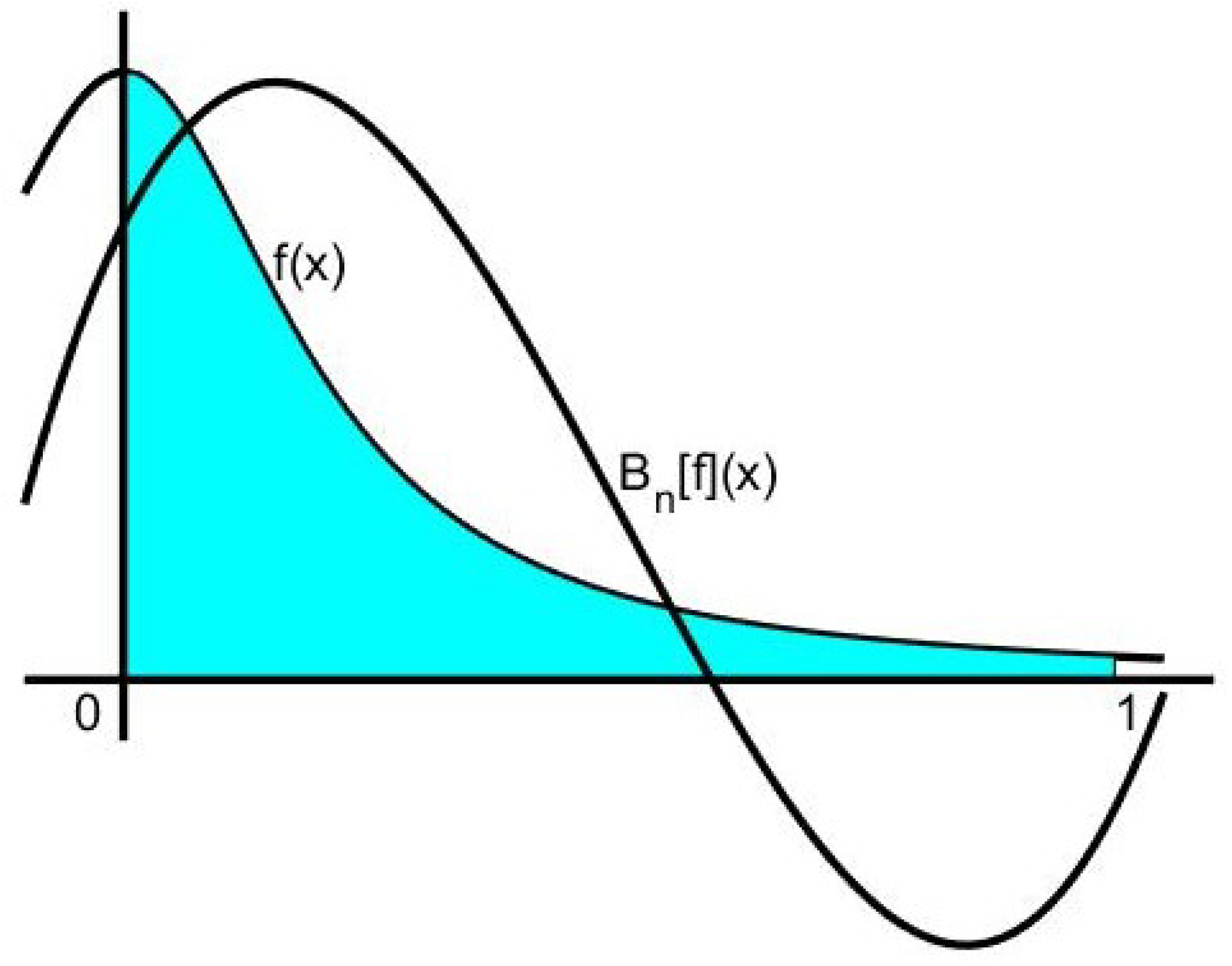
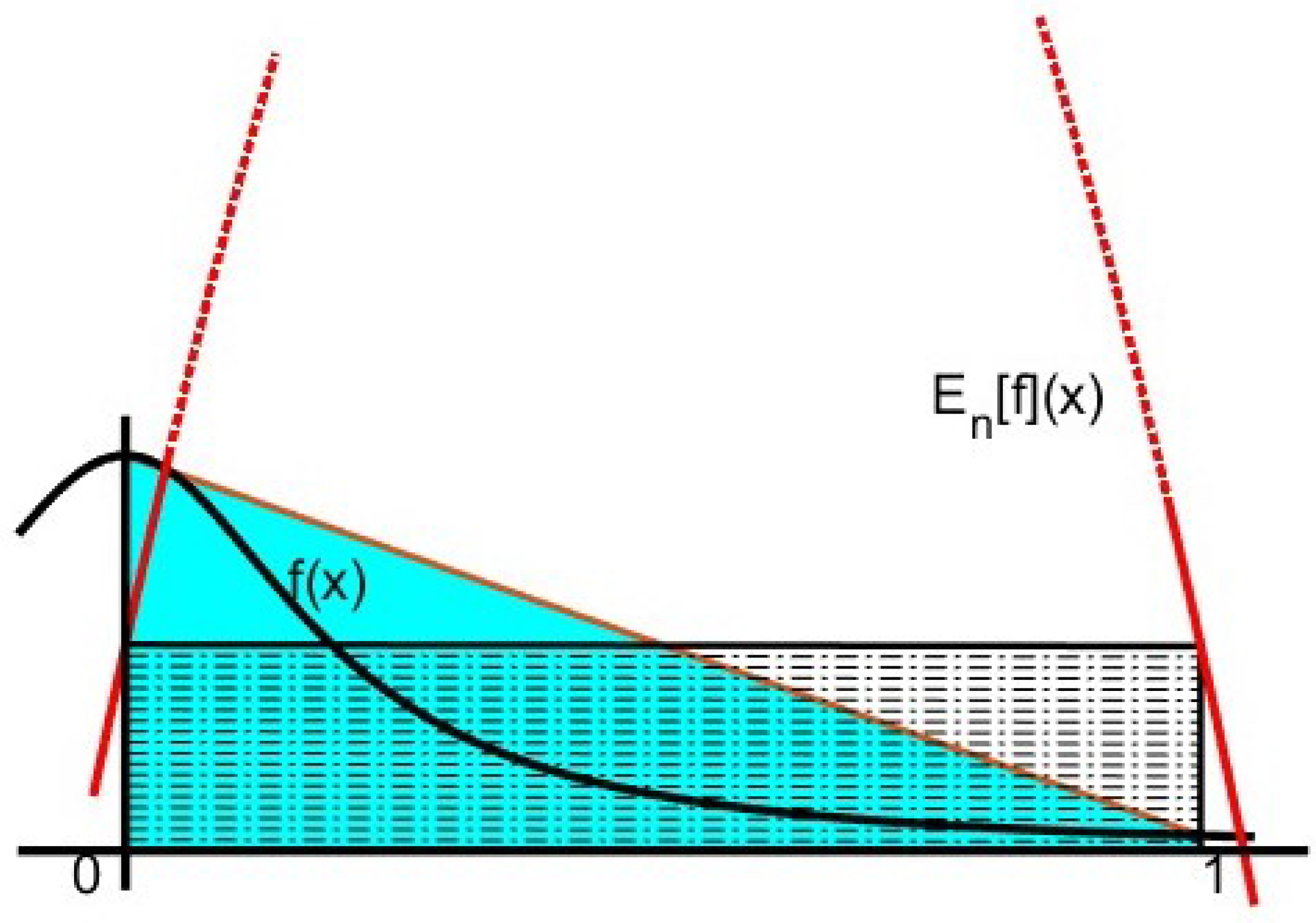
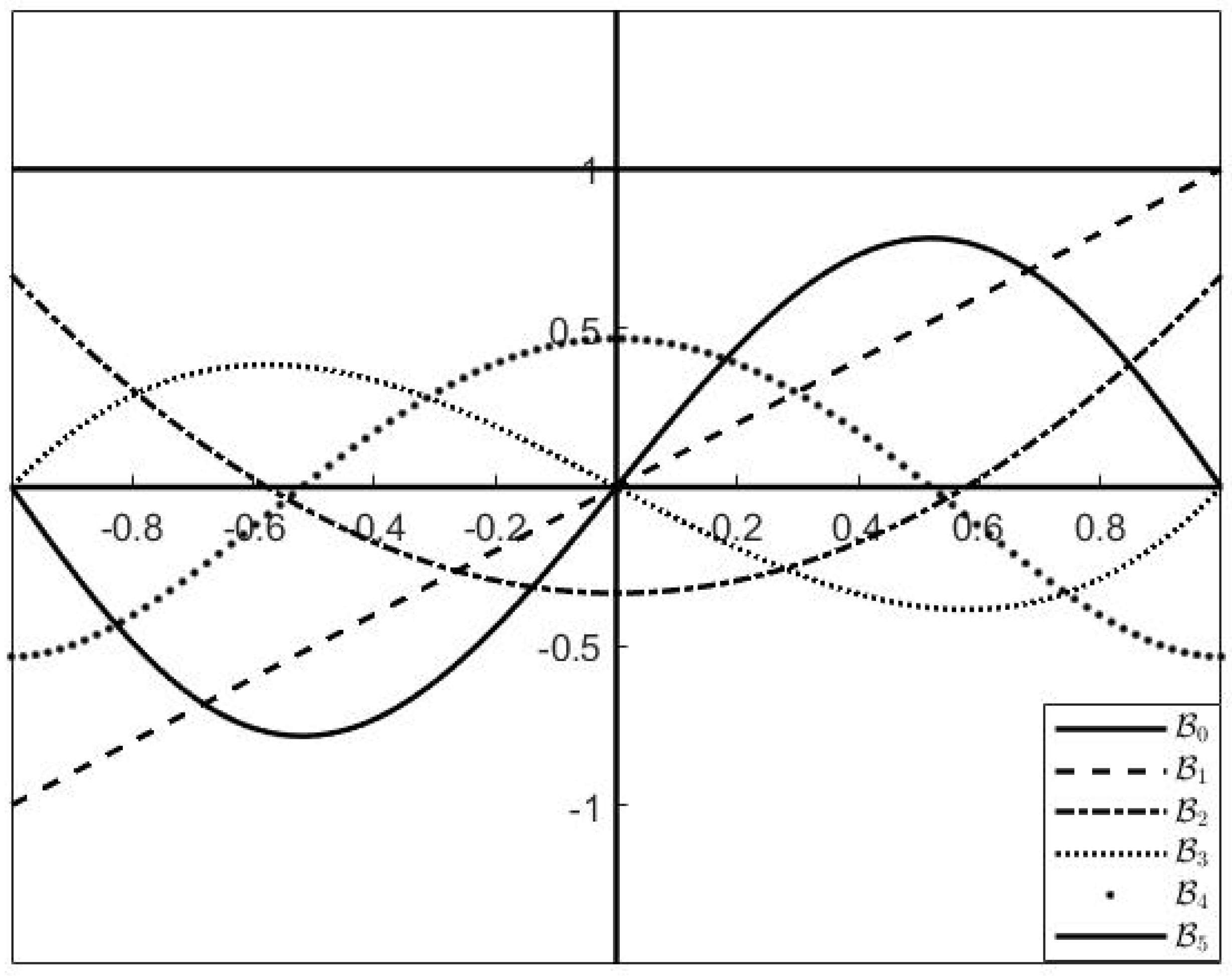
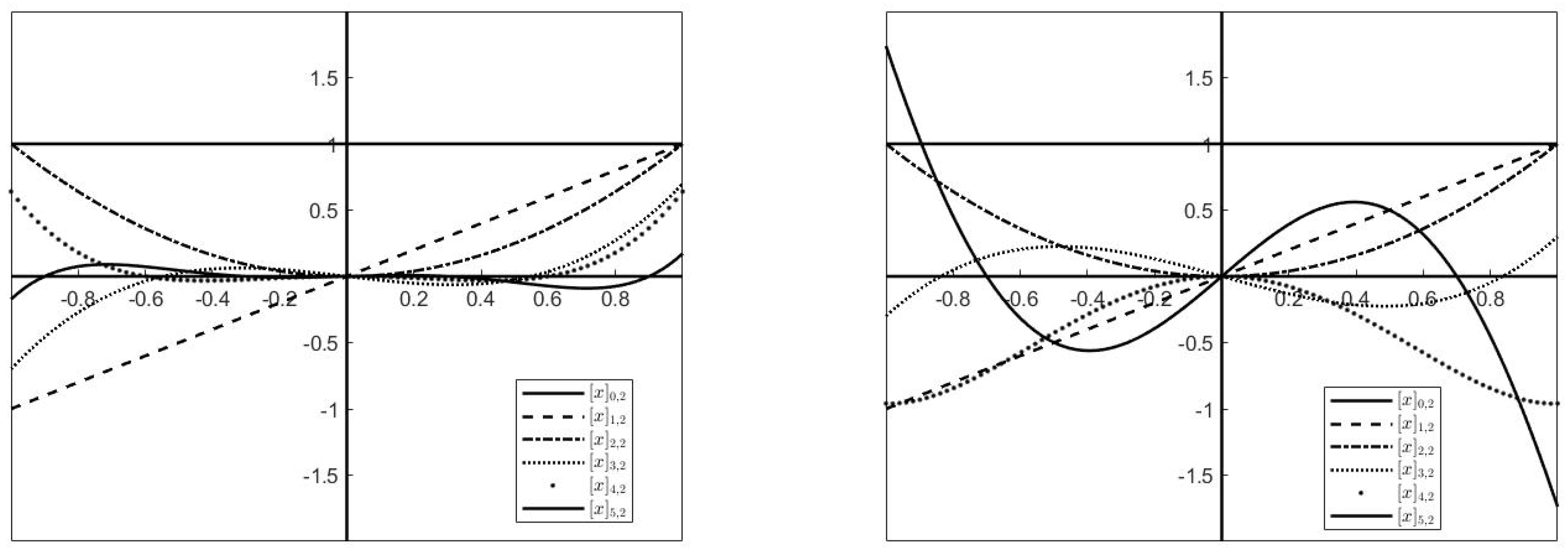


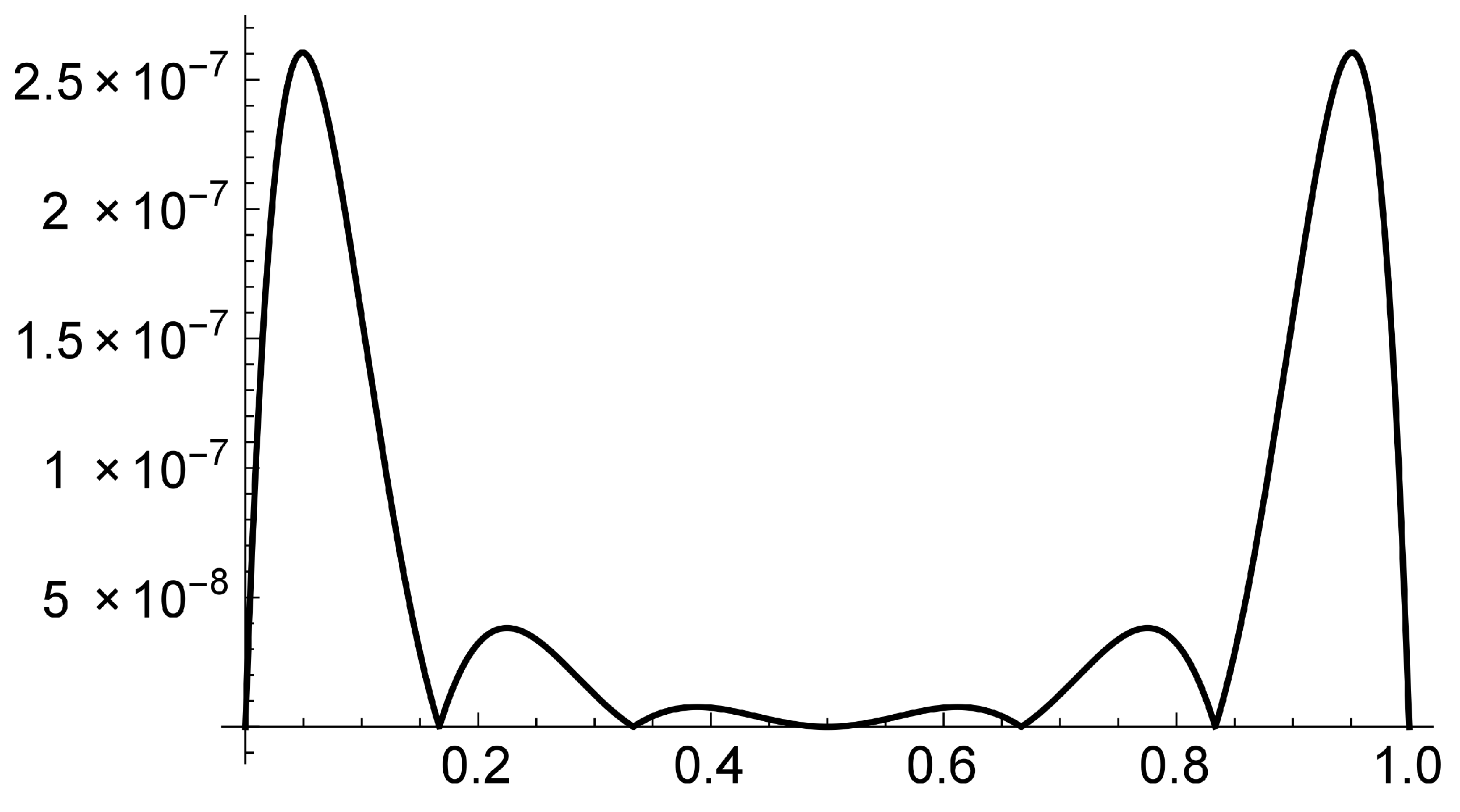
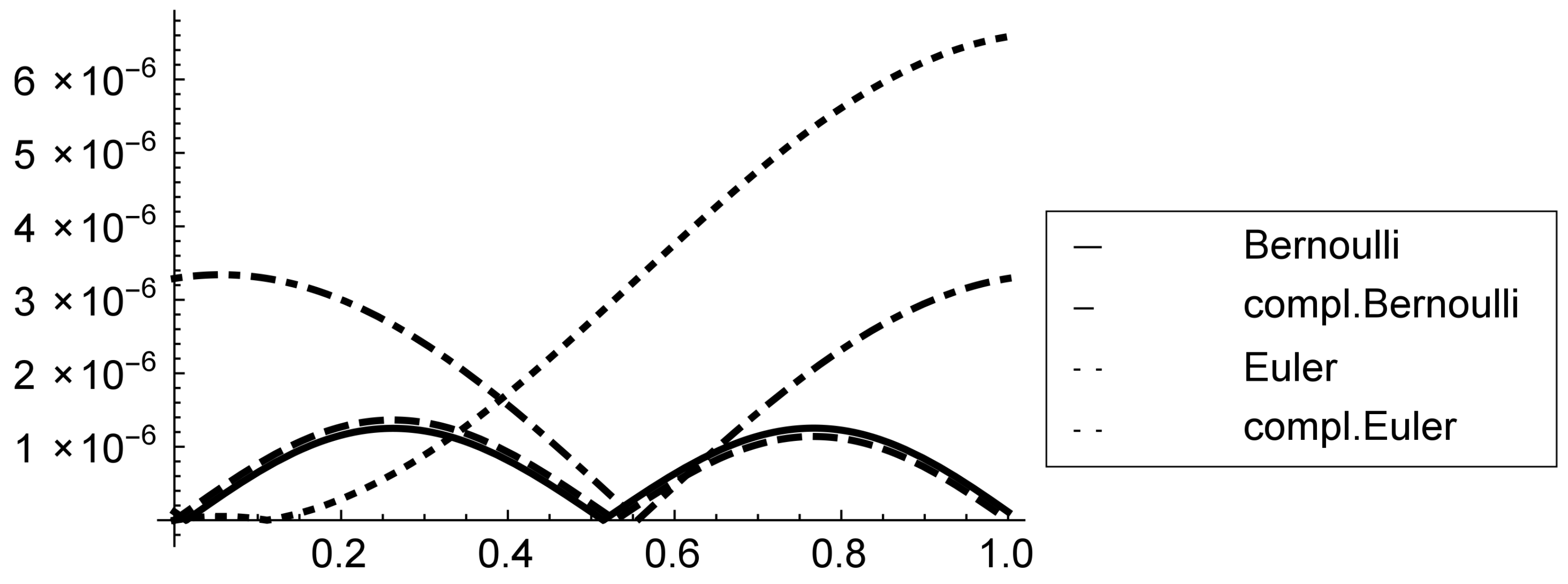
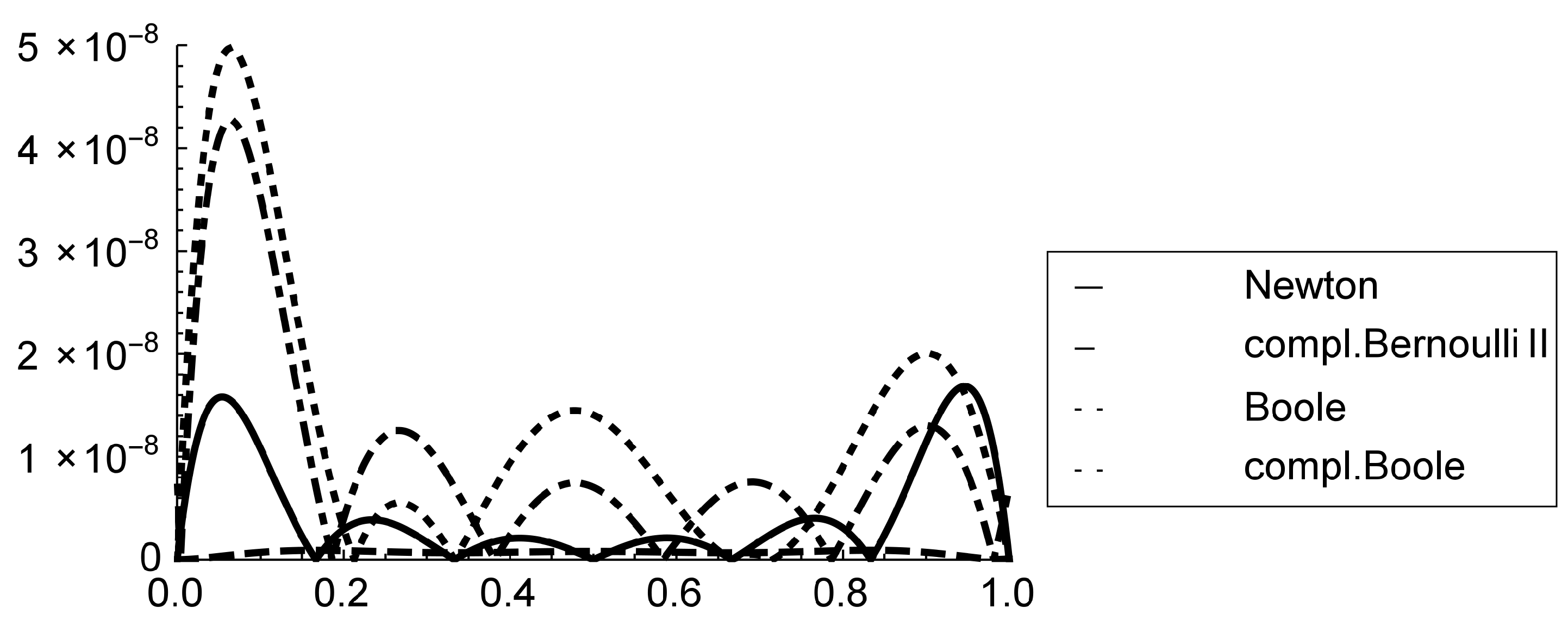

Disclaimer/Publisher’s Note: The statements, opinions and data contained in all publications are solely those of the individual author(s) and contributor(s) and not of MDPI and/or the editor(s). MDPI and/or the editor(s) disclaim responsibility for any injury to people or property resulting from any ideas, methods, instructions or products referred to in the content. |
© 2025 by the authors. Licensee MDPI, Basel, Switzerland. This article is an open access article distributed under the terms and conditions of the Creative Commons Attribution (CC BY) license (https://creativecommons.org/licenses/by/4.0/).
Share and Cite
Costabile, F.A.; Gualtieri, M.I.; Napoli, A. Umbral Interpolation: A Survey. Mathematics 2025, 13, 271. https://doi.org/10.3390/math13020271
Costabile FA, Gualtieri MI, Napoli A. Umbral Interpolation: A Survey. Mathematics. 2025; 13(2):271. https://doi.org/10.3390/math13020271
Chicago/Turabian StyleCostabile, Francesco Aldo, Maria Italia Gualtieri, and Anna Napoli. 2025. "Umbral Interpolation: A Survey" Mathematics 13, no. 2: 271. https://doi.org/10.3390/math13020271
APA StyleCostabile, F. A., Gualtieri, M. I., & Napoli, A. (2025). Umbral Interpolation: A Survey. Mathematics, 13(2), 271. https://doi.org/10.3390/math13020271







